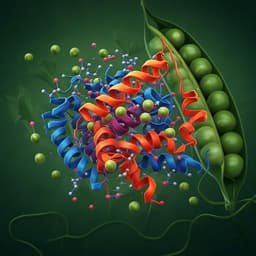
Engineering and Technology
Effects of plasma treatment on biodegradation of natural and synthetic fibers
M. Nyssanbek, N. Kuzina, et al.
This groundbreaking study explores how plasma treatment can boost the biodegradation and structural properties of fibrous composites, notably enhancing the mechanical strength and speeding up biodegradation. Conducted by Marzhan Nyssanbek, Natalya Kuzina, Valery Kondrashchenko, and Abdugani Azimov, the research reveals vital insights into cellulose-based materials, making them more eco-friendly.
Playback language: English
Introduction
The lightweight materials industry faces increasing demands due to population growth. The textile industry uses both natural and synthetic materials, but synthetic fibers pose environmental challenges due to their slow decomposition. A significant portion of polymer waste is incinerated or remains undisposed. Research focuses on biodegradable synthetic polymers and the use of plasma treatment to improve their biodegradability. Plasma treatment modifies the polymer surface structure, enabling more efficient decomposition by biological processes. However, the pathways of biodegradation for various polymer types, influencing factors, resultant products, and efficient biodegradation methods remain underexplored. Some researchers suggest that successful biodegradation of synthetic components in natural-synthetic blends occurs when the natural polymer is chemically attached to the synthetic polymer, initiating degradation from the natural polymer chain. Previous studies have examined epoxy composites reinforced with treated plant fibers, highlighting improved mechanical properties but also increased water absorption with higher fiber loading. Other studies explored the chemical treatment of *Vachellia farnesiana* fibers, showing variations in cellulose content based on the treatment type. Plasma treatment, a dry and clean process, offers an environmentally friendly alternative to chemical treatments for natural fiber surface modification. It enhances binding agent action for improved adhesion, etches the fiber surface, and introduces free radicals, altering the chemical structure without changing material volume. This study aims to investigate the influence of low-temperature plasma treatment on the biodegradability of cellulose and its composites, bridging the gap in existing research on plasma-modified fiber biodegradability.
Literature Review
The literature review section highlights several key studies. Ameer et al. (2017) and Nawab et al. (2018) discussed the interdependence of moisture and mechanical properties in jute fiber composites and the development of green composites using 3D woven preforms, respectively. Cordeiro (2016) and Ershov et al. (2012) explored plasma treatment of natural fibers and the modification of synthetic fibers. Islam et al. (2022) examined lignin-based biomaterials in textile wastewater treatment. Studies by Miroshnichenko et al. (2022), Lebedev et al. (2022), and Meydanju et al. (2022) investigated biodegradable hydrogel films and eco-friendly polymers. Several studies (Karimi Sani et al., 2023; Pirsa & Asadi, 2021; Pirsa & Hafezi, 2023; Pirsa et al., 2021; Hosseini et al., 2021; Yorghanlu et al., 2022) focused on biodegradable films for food packaging applications using various materials and nanoparticles. Shaker et al. (2020) reviewed bio-composites as eco-friendly substitutes. Jabraili et al. (2021) and Tian & Bilal (2020) investigated biodegradable nanocomposite films and biodegradable materials for pollution reduction. Kalimullina et al. (2012) studied plasma modification for hydrophobic surfaces. Raghunathan et al. (2023, 2022) explored the mechanical properties of plant fiber-reinforced composites. Armandei et al. (2015) and Zhang et al. (2017) focused on experimental studies of bamboo and plasma technology for soil remediation, respectively. Zanini et al. (2015), Peran & Ražić (2020), and Ngo et al. (2021) investigated plasma treatment effects on textiles, including flame retardancy. Von Keudell & Schulz-Von Der Gathen (2017) provided an introduction to low-temperature plasma physics. Hamad (2019) explored nanoscale surface modification of ramie fibers. Aghbolagh & Pirsa (2021) examined biodegradable films using mulberry pulp pectin and chlorophyll. Zille (2020) reviewed plasma technology in fashion and textiles. Hamad et al. (2019) and Zhang et al. (2017) studied plasma treatment effects on ramie fibers and polyester fabrics. Abdullin et al. (2011) and Nguyen Thi et al. (2020) investigated gas-discharge modification of textiles and plasma activation in flame-retardant treatment. Kundu et al. (2020) reviewed fire retardant treatments for synthetic textiles. Cools et al. (2014), Jelil (2015), Gibeop et al. (2013) reviewed plasma treatment of textile materials and biodegradable composites. Many studies (Girijappa et al., 2019; Vinod et al., 2019; Lahouioui et al., 2020; Sair et al., 2019; Sumesh et al., 2020; Vijay et al., 2019; Ganapathy et al., 2019; Valášek et al., 2017; Ojha & Biswal, 2019; Krishnan et al., 2020; Mohana Krishnudu et al., 2020; Premnath, 2019; Saba et al., 2019) focused on natural fibers and their composites for sustainable applications.
Methodology
The study employed a methodology that involved four main steps: (1) **Selection of research objects:** Natural softwood fibers and cellulose-containing materials (unbleached softwood sulfate pulp and softwood sulfate lignin) were chosen. SEM analysis determined fiber length and width. (2) **Production of composites:** A solid-state shear pulverization method reduced cellulose particle size before mixing with polypropylene matrix in a plastic mixer at 185°C for 8 minutes. The blend underwent compression molding at 185°C and 10 MPa for 15 minutes. (3) **Low-temperature plasma treatment:** A custom-designed plasma reactor was used. The reactor consists of a radio-frequency induction coil around a borosilicate glass tube, with a gas supply (sulfur hexafluoride (SF6) and water), a vacuum pump, and a stepper motor to rotate the sample holder. Plasma parameters were: I=4.8-5.2 mA; U = 25-28 kW; exposure time = 10-30 min; P= 10² Pa. The treatment procedure included cleaning, sample placement, evacuation, gas introduction, and pumping down to atmospheric pressure. (4) **Treatment of biodegradability and mechanical strength:** Tensile testing (ISO 527) determined mechanical strength, using a universal testing machine with a gauge length of 6 cm and a speed of 5 mm/min (average of 10 samples). Biodegradability testing involved burying samples in soil for 30 days under controlled conditions (25-75% humidity and 15-25°C). Mass loss determined the degradation degree. Statistical analysis used One-way Analysis of Variance (p ≤ 0.05). Gas chromatography (Agilent 7820), high-performance liquid chromatography (ChroZen UHPLC), a gas chromatograph-mass spectrometer (GCMSQP2010 Plus), and other instruments (thermal desorber TD-20, ATR-8200HA attachment (Pike Tech), a scanning electron microscope (SEM) Sigma VP ZEISS, and a probe microscope MultiMode 8) were used for analysis.
Key Findings
The addition of cellulose to fibers significantly improved mechanical strength (18 MPa to 21 MPa, or 16.7% increase). Low-temperature plasma treatment further enhanced this: 33.3% increase for natural fibers (18 MPa to 25 MPa) and 50% for reinforced fibers (18 MPa to 29 MPa). SEM analysis revealed differences in cell wall microfibrils between treated and untreated samples. Untreated fibers showed chips and voids, while treated fibers displayed structural changes resembling wood charring, and in some regions, a hollowed morphology. In cellulose-reinforced polypropylene composites, plasma treatment resulted in fewer defects and improved fiber-matrix adhesion. Analysis of biodegradation products revealed significant differences in composition between treated and untreated fibers, with altered molecular masses and percentage yields for several compounds (e.g., C6H10O5, 3-deoxyglucofuranose, C6H6O3). The yield of levoglucosan (C6H10O5) was 7.92% after plasma treatment. A significant amount (10.1%) of 3-dioxyglucosenone was released. Plasma did not affect sulfate lignin; plasma-treated natural fibers contained 21% lignin, while composites had 18%. Biodegradation of plasma-treated samples began on day 12, while untreated samples showed biodegradation after 19 days, a 7-day difference. Plasma treatment affected the surface properties of materials, enhancing adhesion and durability. It is a more effective and sustainable alternative to chemical methods for enhancing the biodegradability of materials.
Discussion
The findings directly address the research question by demonstrating the significant influence of low-temperature plasma treatment on both the mechanical properties and biodegradability of cellulose-based composites. The increased mechanical strength after plasma treatment is likely due to structural changes at the fiber level, leading to improved fiber-matrix interaction. The accelerated biodegradation observed in plasma-treated samples can be attributed to the structural modifications, making the fibers more susceptible to microbial attack. This aligns with the hypothesis that modifying the surface structure of fibers enhances their biodegradability. The observed differences in biodegradation product compositions highlight the chemical changes induced by plasma treatment. The results are significant for the development of sustainable and environmentally friendly composite materials, as they demonstrate a method for enhancing the biodegradability of traditionally recalcitrant materials while maintaining or improving mechanical properties. The study's findings have broad implications for various industries that utilize fibrous composites, particularly in promoting environmentally responsible material choices.
Conclusion
This study successfully demonstrated the efficacy of low-temperature plasma treatment in enhancing the biodegradability of cellulose and its composites while simultaneously improving mechanical strength. The findings highlight the potential of plasma treatment as a sustainable and effective method for modifying the properties of fibrous materials, paving the way for the development of environmentally friendly composite materials. Future research could explore a wider range of natural and synthetic fibers and optimize plasma treatment parameters for specific applications. Further investigation into the long-term environmental impact of plasma-treated materials and the detailed mechanisms of biodegradation would provide additional insights.
Limitations
The study focused on specific types of natural fibers and polypropylene matrix; therefore, the findings may not be generalizable to all types of fibers and polymer matrices. The biodegradability testing was conducted under controlled laboratory conditions, which may not fully replicate the complex environmental conditions of real-world scenarios. The sample size for some analyses could be increased to enhance statistical power. Further research is necessary to explore the long-term effects of plasma treatment on the biodegradation process and the potential impact of any released byproducts.
Related Publications
Explore these studies to deepen your understanding of the subject.







